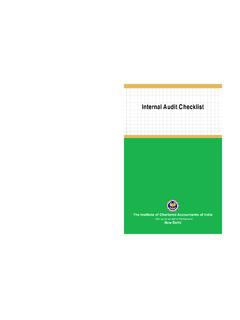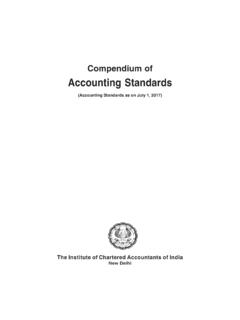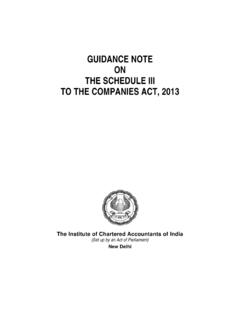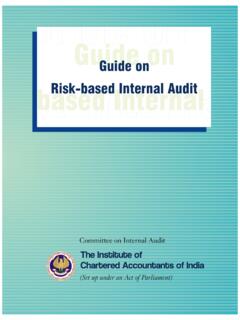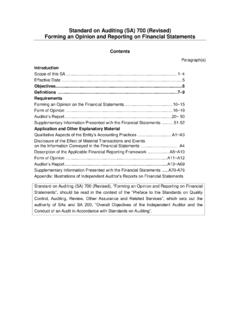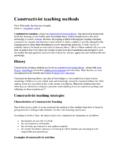Transcription of Handbook on project financing as an area of practice for ...
1 Handbook on project financing as an Area of practice for Small and Medium Practitioners Committee for Capacity Building of CA Firms and Small & Medium Practitioners (CCBCAF & SMP) The Institute of Chartered Accountants of India (Set up by an Act of Parliament) New Delhi The Institute of Chartered Accountants of India All rights reserved. No part of this publication may be reproduced, stored in a retrieval system, or transmitted, in any form, or by any means, electronic, mechanical, photocopying, recording, or otherwise, without prior permission, in writing, from the publisher. DISCLAIMER: The views expressed in this book are those of author(s). The Institute of Chartered Accountants of India may not necessarily subscribe to the views expressed by the author(s).
2 The information cited in this book are drawn from various sources while every efforts have been made to keep the information cited in this book error free, the Institute or any office do not take the responsibility for any typographical or clerical error which may have crept in while compiling the information provided in this book. Further the information provided in this book are subject to the provisions contained under different Acts and members are advised to refer to those relevant provisions also. Edition : February, 2015 Committee/ Department : Committee for Capacity Building of CA Firms and Small & Medium Practitioners (CCBCAF&SMP), ICAI Email : Website : , ISBN : 978-81- 8441-782-1 Price : ` 150/- Published by.
3 The Publication Department on behalf of the Institute of Chartered Accountants of India, ICAI Bhawan, Post Box No. 7100, Indraprastha Marg, New Delhi - 110 002. Printed by : Sahitya Bhawan Publications, Hospital Road, Agra-282 003. February/2015/500 Copies Foreword project financing discipline includes understanding the rationale for project financing , how to prepare the financial plan, assess the risks, design the financing mix, and raise the funds. In addition, one must understand the cogent analyses of why some project financing plans have succeeded while others have failed.
4 A knowledge -base is required regarding the design of contractual arrangements to support project financing ; issues for the host government legislative provisions, public/private infrastructure partnerships, public/private financing structures; credit requirements of lenders, and how to determine the project 's borrowing capacity; how to prepare cash flow projections and use them to measure expected rates of return; tax and accounting considerations; and analytical techniques to validate the project 's feasibility. In the appropriate circumstances, project finance has two important advantages over traditional corporate finance: it can increase the availability of finance, and reduce the overall risk for major project participants, bringing it down to an acceptable level.
5 For a sponsor, a compelling reason to consider using project finance is that the risks of the new project will remain separate from its existing business. Then if the project , large or small, were to fail, this would not jeopardize the financial integrity of the corporate sponsor's core businesses. Proper structuring will also protect the sponsor's capital base and debt capacity and usually allow the new project to be financed without requiring as much sponsor equity as in traditional corporate finance. project finance has enjoyed explosive growth in the past five years. Its emergence has resulted from a number of favorable trends, , privatization, deregulation of industries, new attitudes towards the role of the private sector in developing countries and at the multilateral agencies, etc.
6 CAs generally carries out high quality industry research and analysis because of their strong foundation in Commerce and economics. This helps CAs in rationally evaluating the risks associated with any project financing deal being evaluated. I am glad to know that the Committee for Capacity Building of CA Firms and Small & Medium Practitioners (CCBCAF & SMP) of our Institute has brought out the book on Handbook on project financing as an area of practice for Small and Medium Practitioners . iv I appreciate the efforts put in by the contributors for preparing the Basic Draft of this Book and complement CA. Anuj Goyal, Chairman, CCBCAF&SMP, ICAI and other Members of the Committee for publishing the aforesaid book.
7 January 21, 2015 CA. K. Raghu New Delhi President, ICAI Preface project finance is a long-term method of financing large infrastructure and industrial projects based on the projected cash flow of the finished project rather than the investors' own finances. project finance structures usually involve a number of equity investors as well as a syndicate of banks who will provide loans to the project . They are most commonly non-recourse loans, which are secured by the project assets and paid entirely from project cash flow, rather than from the general assets or creditworthiness of the project sponsors, a decision in part supported by financial modeling. The financing is typically secured by all of the project assets, including the revenue-producing contracts.
8 project lenders are given a lien on all of these assets and are able to assume control of a project if the project company has difficulties complying with the loan terms. Each project financing is different. Each project gives rise to its own unique risks and hence poses its own unique challenges. In every case, the parties - and those advising them - need to act creatively to meet those challenges and to effectively and efficiently minimize the risks embodied in the project in order to ensure that the project financing will be a success. As CAs, our deep understanding of financial statements is very handy in preparing financial models to project revenues and cash flows.
9 Business/ project evaluation is a technique which you will easily pick up once you start working in project financing . This is a skill which bankers develop with experience as they work on more and more transactions. The Committee has prepared this Book on Handbook on project financing as an area of practice for Small and Medium Practitioners . I am confident that this publication would surely help the members in discharging their responsibilities to the profession as well as to the Nation in a very effective manner. I feel great pleasure in acknowledging the efforts and the contribution made by CA. Subhash Nathuramka in preparation of this book on Handbook on project financing as an area of practice for Small and Medium Practitioners.
10 I appreciate the efforts put in by the members of CCBCAF & vi SMP and Dr. Sambit Kumar Mishra & other officials of CCBCAF & SMP Secretariat, who have provided necessary support for publishing the aforesaid book. January 21, 2015 CA. Anuj Goyal Chairman Committee for CapacityBuilding of CA Firms and Small & Medium Practitioners, ICAI Contents Chapter Page No. Foreword iii Preface v 1 Introductory 1 2 Professional Opportunities 2 3 Making preparation for becoming an efficient practitioner 7 4 Identification and Conceptualisation of project 10 5 Appraisal of project and preparation of techno economic viability study report 13 6 Inspection and monitoring of a project 21 7 Process of obtaining External Credit Rating 34 Suggested indicative list of readings and references 45 Important Legislations.
